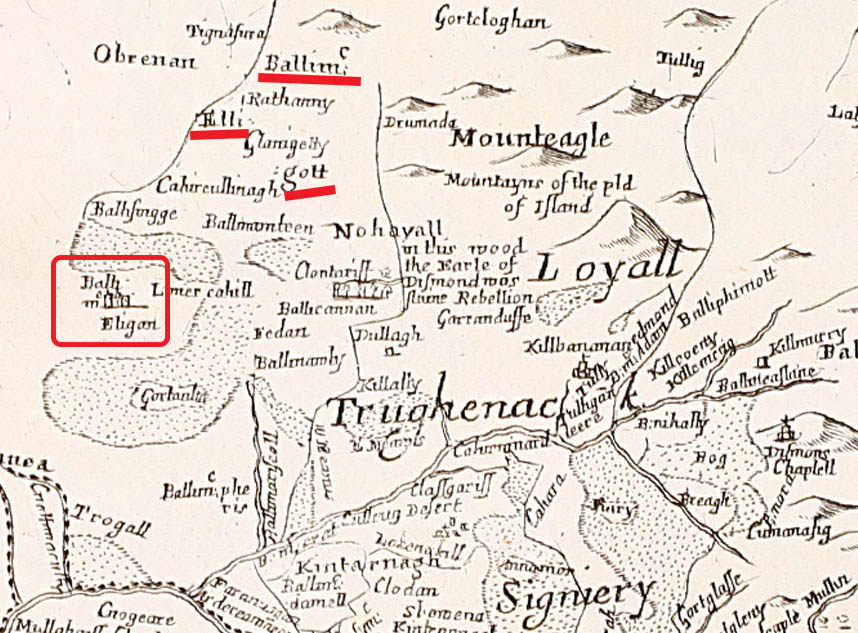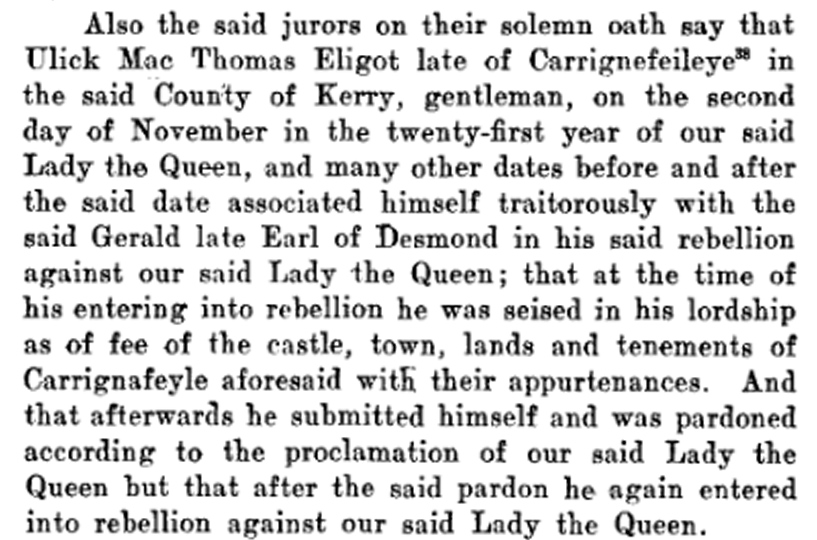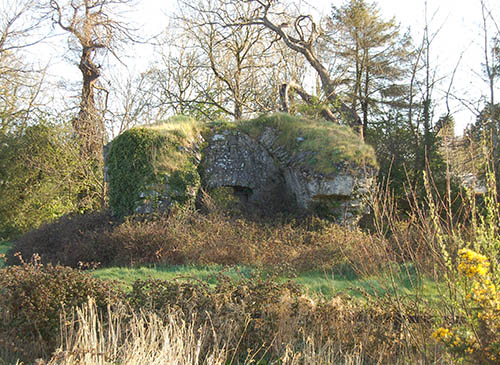In earlier times, the McElligotts held an impressive number of castles in the parish which takes their family name:
Bally Mac Elligot distant to the east from Tralee about three miles, has in it the ruins of some considerable castles but it is chiefly remarkable for its name, which it takes from the Mac Elligots, a potent family in these parts.1

In 1590, the McElligott family was deprived of its four castles, Carrignafeela, Arabela, Bealagrellagh and Ballymacelligott. 2
This followed the family’s open support of Gerald, Earl of Desmond.
Carrignafeela Castle
In an inquisition of 1584, the year after the death of Gerald, Earl of Desmond, it was found that Ulick Mac Thomas Eligot of Carrignafeilye had ‘associated himself traitorously with Gerald, late Earl of Desmond, in his said rebellion against our said Lady the Queen’.3

However, his rebellion did not cease and in 1613, Carrignafeela, ‘a place of note’, was in the possession of Sir T Roper.
In the centuries that followed, names associated with the property included Denny, Vernon and Hurley.4
In about 1870, Rev J Brosnan, parish priest, recorded that the Castle of Carrignafeela had been demolished ‘only a few years since’.5
Arabela Castle
Arabela Castle (or Air Bile Castle), in the townland of Arabela, may have been the original home of the McElligotts.6 The following is taken from Fr Ferris’s Parish Histories:
The McElligotts of Air-Bile had sixty-five cows. Two sons married in the place. There was no division of property. Their wives quarrelled. On a fine June evening, the cows were left unmilked through their quarrel. The cows’ strange and weird bellowing brought the whole parish to look at them. In five years from that date, no McElligott was left.
Arabela Castle was supposed to have been a residence of the King of West Munster, as recorded in the Book of Rights. In about 1870, Rev J Brosnan, parish priest, stated that the castle at Arabela had been demolished ‘some eighty years ago’.7
Bealagrellagh Castle
Bealagrellagh Castle appears as the longest surviving ruin of the McElligott castles.8 Donovan gave a good description of it in 1841:
In the South East corner of this townland of Ballygrellagh stands the ruin of an old castle said to have been built by the Mac Elligots. The name signifies mouth of the miry ford which is truly description of the locality. The castle measures on the inside 22ft 7in in length from north to south and 13ft 10in from east to west and its walls are 7 feet thick at the base and well grouted. All its features are disfigured except two narrow windows on spikes on the east side; these are of cut limestone, and one of them is pointed and the other rectangular at top. The third floor rested on a stone arch which is nearly destroyed. The doorway is on the west side; it is rudely formed and measures as it now stands 7ft in height and 4ft in width.
In about 1870, Rev J Brosnan, parish priest, recorded that the castle was ‘a substantial two-stories square block of walls; the upper floor whole, and overgrown with luxuriant grass; the basement story affording beasts agreeable shelter from the heat and cold’.9
In 1924, the castle was demolished for road building material. A correspondent of the Irish Independent wrote:
Who is responsible for the demolition of the 14th century castle on the Ballymacelligott road to Tralee? Are the Commissioners and Co Council aware of this vandalism? This act of desecration is on a par with the basest instincts that prompted the wholesale destruction of valuable property for which this district is now notorious.10

W G Strickland, Hon General Secretary of the Royal Society of Antiquaries, responded to the outrage and said it was hoped such future acts would be restrained by legislation.11
Irish politician Kathleen Anne Browne (1876-1943) also responded. Writing from Rathronan Castle, Co Wexford, she stated that destruction such as Bealagrellagh had been going on ‘unchecked and sometimes almost unnoticed’ since the land passed into the hands of the people. ‘The old landlords’ she wrote, whatever their faults, in the majority of cases preserved and protected the relics of the past’.12
Ballymacelligott Castle, otherwise Desmond Castle
Perhaps most interesting of the four castles in this parish was Ballymacelligott Castle, which, according to tradition, stood in the townland of Tooreen.13 In the mid nineteenth century, there was nothing left but ‘a heap of small stones overgrown with moss.’14
It was known as the Earl’s Castle as it numbered among those, like Port Castle in Abbeyfeale, where the Earl of Desmond took refuge before his death at Glanageenty in 1583.15
Lemercahel Castle
Fr Ferris’s Parish Histories identifies another castle in the parish of Ballymacelligott. It is shown on the map of the Geraldine Confiscation dated 8 March 1587.16
Lemercahel Castle, associated with the names Denny and Herbert, was situated in the townland of Rockfield.17
The last vestige of Bealagrellagh stands alone as reminder of the Ballymacelligott castles of long ago. We would do well to take care of it.
_______________
1 O’Donovan Letters. O’Donovan added that the McElligotts were descended from the Mac Clowds of the Isle of Skith in Scotland who came into Ireland with Galfridus de Marisco, Justice of Ireland. This was disputed in 1914 by Kerry historian, Jeremiah King, who stated that ‘authorities differ considerably as to the origin of the Mac Elligott family. Carew includes them among the ‘mere Irishry’ of Kerry although in the letters patent conferring their lands upon English adventurers, it is implied that they were of foreign origin. Some again say that they are of Scotch descent, while others regard them, like the MacGiolla Cudas, as a branch of the Ua Suileabhans. Ua Donnabhain says that they are probably descended from Eleget, or Mac Eileagoid, Seneschal of Connacht, who was slain at Bungalvy Castle in Galway in 1247 during O’Connor’s war against the English of Connacht … There is no reason to speculate as to the origin of the Mac Elligotts. It is quite clear that the name is an old Kerry one and that the clan (with the O’Connors and O’Leynes) held most of the district between Listowel, Tralee and Castleisland before the Normans settled in Kerry. O’Donovan was not versed in Kerry family history and Rowan withdrew the suggestion of the family being a junior branch of the Scottish Eliots. The family is not a branch of the Mac Gillicuddy O’Sullivans but the names were confused by English writers.’ 2 King’s History (1914) published in Kerry Evening Post, 14 February 1914. Spellings varied, with a query on Ardballa (Arabela?). It is to be noted that Bealagrellagh is in the parish of Ballyseedy. Spelling variants include MacAlgot, Algo, Igo, McEgo, MacElgot, McEiligo, Elligod, Ellicole, Elliott (‘The Family of Igoe’, Independent, 3 October 1935). 3 ‘Ulick Mac Thomas Eligot of Carrignafeilye associated himself traitorously with the said Gerald, late Earl of Desmond, in his said rebellion against our said Lady the Queen; that at the time of his entering into rebellion he was seized in his lordship as of two of the castles, town, lands and tenements of Carrignafeyle aforesaid with their appurtenances. And that afterwards he submitted himself and was pardoned according to the proclamation of our said Lady the Queen but that after the said pardon he again entered into rebellion against our said Lady the Queen’. In 1613 the lands of this Ulick Mac Elligott were granted to Sir T Roper. Mr J C Hurly was in 1613 the owner of Carrignafeela. See King’s history. 4 ‘In 1756 Smith mentions Carrignafeela as a ‘place of some note’ and the residence of a Mr Vernon. It was at one time a seat of the Dennys. The castle and house have both disappeared and the land is the property of Mr J C Hurley’ (‘Inquisition of 1584’ by W M Hennessy, Kerry Archaeological Magazine, Vol 1, No 5 (Oct 1910), p270). 5 A History of the Kingdom of Kerry (1871) by M F Cusack. Near the castle was McElligott’s Prison. Local tradition has it the jail was used by a tyrant of the McElligotts to hang people for the amusement of his family. A story in The Schools’ Collection relates that ‘The gallows was in the jail until sixty years ago’ (ie: 1870s) when it was taken down by the grandfather of a local smith – John Twomey at Maglass. This story is also recorded in Cusack’s history and Fr Ferris’s parish histories. See also The Landlord’s Daughter of Ballymacelligott in The Schools’ Collection. 6 Arabela neighbours the townland of Ballymacelligott. The castle is denoted Mc Elligott’s Castle (otherwise Castle McElligott and Caislean Mhic Giolla Góid) on the nineteenth century OSI maps. King also notes the name Ardballa and Fr Ferris, in Fr Ferris’s Parish Histories (2018) edited by Brendan McCarthy, denotes the townland as Air Bile or Ard Bile, ‘the great tree or verge’. 7 A History of the Kingdom of Kerry (1871) by M F Cusack. In 1841, Donovan, in his Name Books, noted that nothing remained but traces of the foundations and a portion of one wall 30ft in length and about 12 ft in height at the South East corner. See also www.logainm.ie and ‘The Castles & Abbeys of the Co Kerry’ by James Coleman, Kerry Archaeological Magazine, Vol 1, No 3 (Oct 1909), pp 148-150. 8 Bealagrellagh townland, Ballyseedy parish; var: Ballingrilough, Ballynagrilla, Bernagrillagh, Bealnalough. 9 A History of the Kingdom of Kerry (1871) by M F Cusack. 10 The writer, who signed themselves Desmond, continued: ‘Surely it is easily seen this act is totally unnecessary. Are the stones being utilised for road material? Has this particular stone been condemned by Mr Quigley? In addition the stones from the old castle are in a mouldering state and practically fall into dust when separated from the mortar. I appeal to the Antiquarian Society to step in and insist on the application of law against those who are responsible’ (Irish Independent, 18 December 1924). In January 1925, a reporter for the Evening Herald, remarked that ‘The old castle of Ballingrilough near Ballymacelligott which is being dismantled, seems, in addition to its loss from a historical point of view, an unnecessary act if the stones are to be used for building purposes as … there are fine limestone quarries near Ballymacelligott.’ An item in The Schools’ Collection (Volume 0441, Page 211), confirms the destruction was for building purposes: ‘The castle was in a fair state of preservation up to a few years ago when it was destroyed by being demolished for its stones to be used as road material’. 11 Irish Independent, 22 December 1924. 12 Irish Independent, 22 December 1924. Miss Browne, author of The Educational Local Histories Wexford: For Senior Pupils in National Schools (1927) and Was Wexford betrayed to Cromwell?: The Truth (1940), added, ‘Our people are the most ignorant in Western Europe. Our great danger, political and otherwise, arises from this … The storing by the irregulars of their explosives, ammunition and bomb-making machines in the Record Office of the Four Courts followed by their concentration on the destruction of the historic homes of Irishmen – many of whom had given their whole lives in the service of the country – with their priceless libraries, heirlooms and national treasures are actions which have never been equalled by Morrogh the Burner, Cromwell, or any other iconoclast that ever cursed Ireland.’ 13 Otherwise Tureen or An Tuairín. 14 Donovan’s Letters, 1841. Denoted ‘Desmond Castle’ on the nineteenth century OSI maps. Fr Ferris, in his parish histories, suggested that there was no such castle, as the depositions of the earl’s assailants described a cabin, not a castle. ‘I believe tradition has wrongly deduced the presence of a castle here from the fact of the earl’s capture.’ See discourse about the Earl’s Castle and the place of his murder on pp130-132 of Fr Ferris’s Parish Histories BallymacElligott, Ballyseedy, O’Brennan and Nohoval (2018) edited by Brendan McCarthy. 15 Glanageenty townland also lies in the parish of Ballymacelligott. Further reference, ‘The Seigniory of Castleisland’ in the O’Donohoe Catalogue. 16 Fr Ferris’s Parish Histories BallymacElligott, Ballyseedy, O’Brennan and Nohoval (2018) edited by Brendan McCarthy, p215. Map entitled ‘the Description of the Manor and Abbye of Tralye with the lands adjoining lately escheated to her majesty’. 17 See www.logainm.ie for spelling variations.


